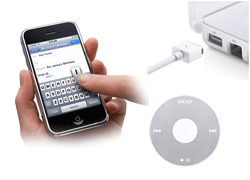 I know you may be getting tired of me always using Apple as an example, but please bear with me for this post. I’ve recently been thinking about how Apple markets their products, and this somewhat ties in to my yesterday’s post on the Nokia N97.
I know you may be getting tired of me always using Apple as an example, but please bear with me for this post. I’ve recently been thinking about how Apple markets their products, and this somewhat ties in to my yesterday’s post on the Nokia N97.
I think what Apple is doing is actually very clever. They’re creating and marketing something that I’ll call ‘interface features’. These are the various interface elements that help you interact with the product, be it a keyboard, trackpad, touchscreen, mouse or a scroll wheel. With their regular product updates they not only change the looks of their products, they also refresh one or two interface elements and market them as new features. Let me illustrate.
Just look at the promotional page for the MacBook Pro. The four features listed on the landing page below the product pictures are:
- Unibody enclosure
- Glass LED display
- NVIDIA graphics
- Buttonless glass trackpad
Out of the four, three of them focus on the interface. The new unibody enclosure design. The glass LED display. The new glass trackpad without any buttons. Only one of the features focuses on actual product performance – the new NVIDIA graphics chip. Other interface features include things like the backlit keyboard, the iSight camera, the magnetic latch, the battery life indicator on the side and the MagSafe power adapter.
Interface features differentiate
I think those interface features are the key in selling a consumer technology product. Sure, your computer or mobile phone may have more storage space and a faster processor, but those things are invisible. The user cannot see or touch them – they’re just numbers. Yes, they may feel an increase in performance, but this is nothing like using and experiencing interface features like a buttonless glass trackpad that they’ve not seen on a competitor’s product.
Look at the other stuff they’ve introduced: the iPhone touch screen and accelerometer, the iPod click wheel, the round scroll wheel on their mouse. These may be big things like the touch screen, or really small things like the mouse wheel, but they are all unique to Apple’s product – or at least were unique when they launched them.
Interface features are the things that you can see, touch and feel – and experience. These are the things that deliver user experience because they are the bridge that gives you access to the functions of that product. To make that bridge easier and faster to cross you need to work on reducing interface friction and make the interface more enjoyable to use.
Interface features sell
Apple does this by constantly thinking of new ways to interact with their products and making their interface features just a little bit different than that of the competition. This gives them the edge. People can see and experience the difference. Apple aren’t marketing performance and hardware. All of those things are a given. They’re marketing new ways of interacting with their products – new interface features that will make your use of their products more productive and fun.
If you’re in a business of selling consumer products, you should focus on and market those interface features. These are the things that will really set your product apart from the rest. Don’t just update the hardware and the looks of your gadget. Innovate. Come up with a couple of unique interface features that will make your product easier and more fun to use. They don’t have to be big, but they need to be unique. Things that the competition doesn’t have.
These are the things that will sell your product – not more memory and a faster chip.